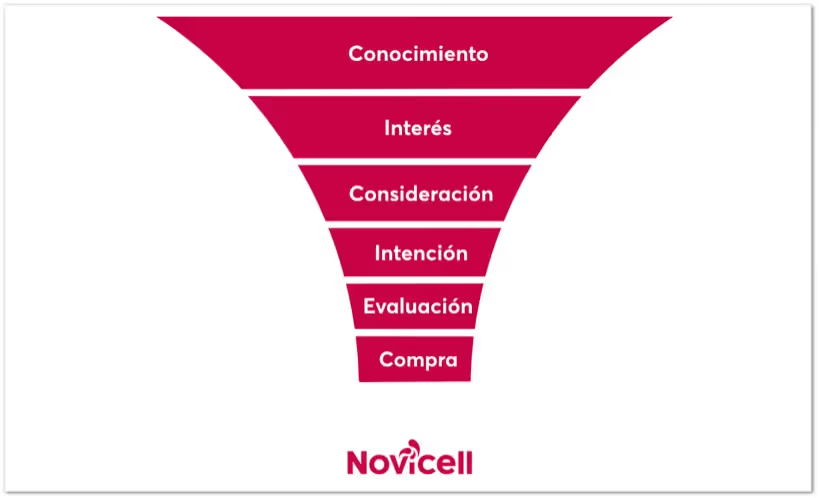Inbound Marketing: Methodology and Strategy

What is Inbound Marketing?
Surely you have heard on more than one occasion the term”Inbound Marketing”, but do you really know what it is?
In a simple way, we can define Inbound Marketing as a set of techniques within a marketing strategy in which a company uses quality content and valuable information to attract potential customers to our company.
People who visit our website do not have to be interested in buying or acquiring one of our services at that precise moment. But if we offer them Valuable content, when they want to buy any of our products or services, they will surely think or remember us since we have been impacting them from time to time with interesting content.
Really understanding what Inbound Marketing is can help us to grow our business and, expand and build customer loyalty.
A bit of history about Inbound Marketing
The Internet was the one that turned marketing around. The first search engine was launched in 1995, the word SEO was coined in 1997, and PPC advertising took hold in 2000. A few years later, social networks would arrive, LinkedIn was founded in 2002, Facebook in 2004, YouTube in 2005 and Twitter in 2006. And starting in 2008, with the arrival of the iPhone 3G, it began to be noticed that the digital landscape would change forever.
As the Internet became more pervasive, consumer habits changed dramatically and companies had to adapt to survive. Currently, consumers no longer want to be impacted like they did years ago through brochures, posters, etc. but they start to want live unique and personal experiences. This means that companies must think about and create new user experiences that make sense for each individual consumer at every stage of Customer Journey.
The term Inbound Marketing was invented in 2005 by Brian Halligan (co-founder and CEO of Hubspot), who defines it as follows:”Inbound marketing focuses on attracting customers through relevant and useful content”.
Neil Patel, one of the 10 most important marketing specialists in the world according to Forbes, also has a simple and brief summary of how and why Inbound Marketing works:”Instead of competing for advertising space and buying advertising, it's better to focus on developing a blog, having an SEO presence and being on social networks. The goal is to attract users to your content in an organic way, instead of attracting them through outbound methods such as Google Ads”.
El Inbound Marketing, is currently a Marketing strategy designed to attract potential customers by offering content of interest oriented to their needs and inquiries as consumers. Many forms or tools of Pull Marketing are used to attract users, such as: Content marketing, blogs, events, SEO, Social Media, emailing, etc. to create brand awareness and Attract new customers.
At Novicell, we believe that an Inbound Marketing strategy is essential for obtaining quality leads, but the best thing is to adapt it for each client and not generalize it like Hubspot did, which for them focuses only on the organic part and the SEM (paid advertising) I wouldn't fall into what Inbound Marketing would be.
If we want to achieve our objectives and be able to reach new users and obtain quality leads, the best thing is that within our digital strategy we consider both organic and paid actions. If we only focus on the organic part, we will surely take longer to position and get quality leads.

Why should you implement an Inbound Marketing strategy?
Below we show a series of statistics that certify why Inbound Marketing is important for a company and, why a strategy is worth implementing.
- Leads that come from Inbound Marketing have a sales closing rate of 14.6%. And leads that arrive via direct mail have a sales closing rate of 1.7%.
- In the world, there are about 3 billion users who have a smartphone, which means that they trust their digital devices to buy and get information, there is no doubt that Inbound Marketing can only grow.
- Inbound Marketing offers a 61% cheaper cost per lead than traditional marketing.
- Social Media and SEO each produce 14% of all leads.
- 79% of top marketers consider blogging to be the most effective marketing tactic.
- 27% of marketing experts say that Social Media and email marketing have a lower than average cost per lead.
- 15% of professionals confirm that SEO offers them higher-than-average sales conversion rates. Companies that published more than 16 blog posts per month got almost 3.5 times more traffic than companies that published between 0 and 4 posts per month.
- The average cost per lead drops by 80% after 5 months of carrying out constant Inbound Marketing actions.
- Content marketing costs 62% less than traditional marketing and triples leads.
- 75% of companies that practice Inbound Marketing believe that their marketing strategy is effective.
- 63% of marketers say their main challenge is to generate traffic and leads.
Inbound Marketing Methodology
The Inbound Marketing methodology has become an essential part of Marketing strategies from all over the world. Inbound Marketing is a highly effective method that takes advantage of personalized content and focuses on getting visitors for a company and converting them into loyal customers.
You don't need great tools to increase the number of leads, and if you want to use tools, you don't need to hire expensive tools either, there are free and/or inexpensive tools that can help you achieve your goals just as well as those at a higher cost.
As we mentioned before, if we accepted the Hubspot definition, Inbound Marketing would practically consist of SEO and Content Marketing strategies, which are a very good practice but slow. Let's imagine that we founded our own company and we try to position it only based on organic content. In order to catch up and overtake our competition, we should invest a lot of efforts. On the other hand if we combined an SEO and SEM strategy, we would surely get a higher view more quickly.
As we have mentioned, Inbound Marketing is made up of a group of techniques, methodologies, tools and actions that together serve to attract traffic to our page, both organically and for payment.
Structure of the Inbound Marketing Methodology
Las 4 stages of the Inbound Marketing methodology They are: Attract, Convert, Sell and Build loyalty. If these steps are followed, we will be able to direct and turn users into prescribers of our brand. At each stage there are specific methods by which we will achieve the conversion. It is It is important that our marketing actions are timely and selective, and this is exactly what the Inbound Marketing methodology helps you to do.

1- ATTRACT
For the entire Inbound Marketing process to begin, the first step is always to attract users to the brand's website, but in order to achieve this, we must think about and prepare an optimal digital strategy.
However, we do not seek to generate mass visits, but rather we focus on attracting quality users to our website, users that match the ideal customer profile, the so-called Buyer People. Therefore, within our strategy, we will describe the different marketing techniques that we will use to achieve our objectives, and the tactics that will keep users coming back.
Some techniques to attract users to our website:
- Content Marketing: The Blog is a great way to drive traffic to our website. Creating interesting and valuable content for the user is key in Inbound Marketing. The blog is the ideal place to start.
- Web Optimization: Providing users with valuable content when they need it will reinforce the attraction process.
- SEO: If we work to position our website in the top positions of the different search engines, our website will work as a response to the user's needs at the right time.
- WITHOUT: Paid advertising offers us a multitude of opportunities to attract traffic that is interested in our products or services through Search, Display, Remarketing, Shopping, Video and UAC (Universal App Campaigns) campaigns.
- Social Networks: They are used as dissemination channels to help our content reach users. It's important to be on the platforms where our customers are.
- Social Ads: Paid advertising on Social Networks is essential to attract potential customers to our company page. They are the optimal way for our investment to obtain a high ROI thanks to the segmentation capacity offered by these channels.
2- CONVERT
Once we have managed to attract the user to our website, what we want is for them to provide us with their data so that we can convert them into a lead and enter them in our database so that they can continue to receive our information.
To turn users into potential customers, the classic strategy is to provide them with valuable content in exchange for leaving their data in a form. But there are many other ways to obtain customer data, such as holding seminars, creating whitepapers, offering a report, attending meetings, through phone calls or a chatbot. In the end, the objective is always the same, to obtain customer data to enter them in our Database, but it is important to follow the New Data Protection Act that came into effect on May 25, 2018.

Some techniques to get leads for our company:
- Call-To-Actions (CTA): Call to Actions are buttons or links on our website that seek to attract users (leads) and turn them into end customers. This action can be, for example: “Download a Whitepaper” or “Register for the seminar”. Los Call-To-Action buttons should be eye-catching and attractive, with clear text that encourages the user to click.
- Landing Pages: These would be the landing pages for Call-to-Actions. Landing pages, also known as landing pages, should always include a form for users to fill out with their contact details. Once users have filled it out and accepted the conditions, they will have access to the resource highlighted in the CTA.
- Chatbots: Los Chatbots can help us capture user data in order to build a database of people who are interested in our business. Chatbots can be integrated into several pages of the web, and we can even implement them on social networks. Chatbots can provide answers 24 hours a day, seven days a week, allowing us to provide a good user experience.
3- SELL
The next step in Inbound Marketing, After attracting and converting the user, it's getting your lead to become a satisfied customer. The process doesn't end when we manage to convert a lead into a customer. The next step we must take is to make this potential customer stay with us, and the best way to achieve this is through loyalty strategies, such as: Newsletters, offers and incentives.
The objective of this stage is to focus on the consumer, on The Marketing and Sales Department must join forces in this process. As we have already commented on more than one occasion in our articles,”keeping a customer is much less expensive than getting a new one from scratch”.
There are different tools and techniques that help us build customer loyalty:
- Email Marketing: Another method to convert our customers is through email. El Email Marketing it's a good tactic for customers who have already interacted with our content, but haven't yet made the decision to buy. The goal is to gain their trust so they can take the final leap.. Sending through a monthly newsletter, or the most relevant content and offers of the week, can be an excellent way to achieve this.
- Marketing Automation: Marketing automation allows us to educate a contact through the buying process. The techniques of Marketing automation are: Lead nurturing (it's about sending personalized information to users depending on the moment of decision they are in) and the Lead Scoring (it is the temperature of a lead, that is, it measures the degree of interest of a user).
- CRO (Conversion Rate Optimization): Sometimes we can see how we receive visits on our website but they don't convert, but the solution is found in Conversion Rate Optimization. A good CRO strategy will allow us to know user behavior, maximize investment returns, detect opportunities for improvement, convert traffic into sales and increase the number of leads.
- Analysis: Once our digital strategy has been implemented, and a large amount of content has been published both on the blog and on our website, we can already see some results. Analysis is key to understanding the performance of our Inbound Marketing strategy and seeing what areas can be improved. One of the best ways to visualize data for further analysis is through Marketing Dashboards, allow you to visualize interactive data in a more visual and faster way.
But before we start analyzing, the first thing to do is define KPIs, the most relevant metrics to evaluate if the strategy is succeeding or not. We'll start the analysis with the upper half of the conversion funnel. For example, search for a specific landing page and identify how many visits and leads we have received, and see what the conversion rate is.

4- BUILD LOYALTY
You can never abandon a customer once they have made a purchase, quite the contrary, even the most satisfied customers need to be taken care of, to be made to feel special. We need to turn our customers into brand prescribersa, and we can only achieve that by showing that we value them and that we don't forget them.
One of the best ways to achieve this is by interacting with them through email, social media, and even inviting them to special meetings.

Having an Inbound Marketing strategy is a competitive advantage for a company. It is very important to build strong and lasting relationships with our clients, it should be noted that the company thinks and cares about the needs of its customers, and the best way to achieve this is by knowing who our users are.
As we have seen in this article, The methodology of Inbound Marketing is very broad, the one that works for one company may not work for another, so it is important that each company has an Inbound Marketing strategy customized to its objectives.
And we can't forget that Inbound Marketing allows us to know what each user needs at all times, and thanks to this, we can offer personalized content to each of our clients depending on the phase they are in.
How can we help you with Inbound Marketing?
If you need more information, do not hesitate to contact us.
Cómo podemos ayudarte
Consulta los servicios con los que te ayudaremos a conseguir tus objetivos digitales.
